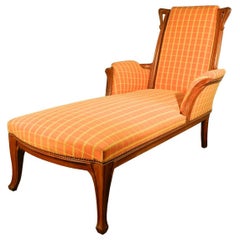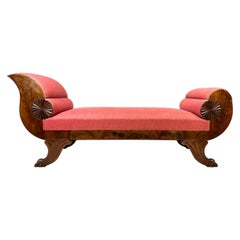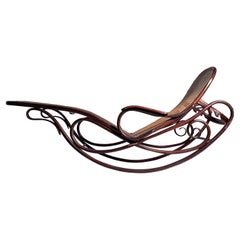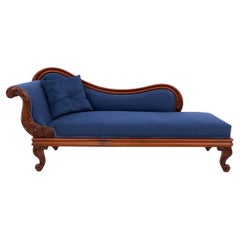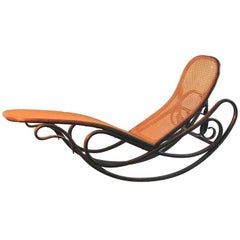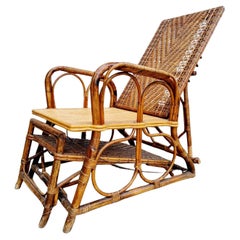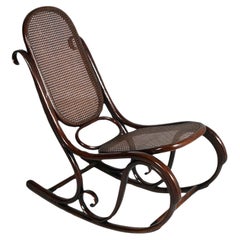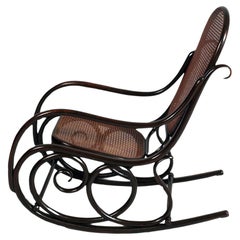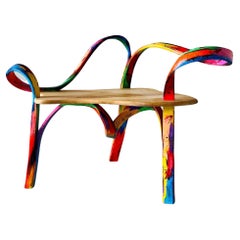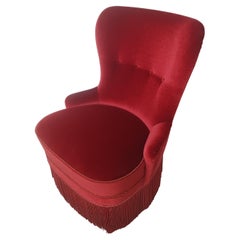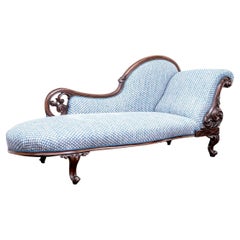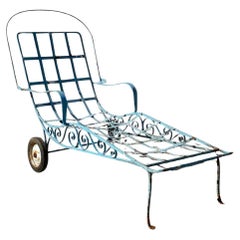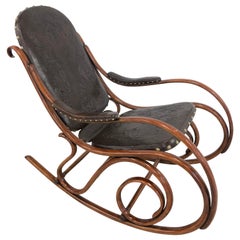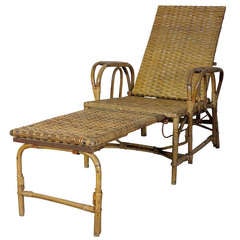Art Nouveau Chaise Lounge
Antique Early 1900s French Art Nouveau Chaise Longues
Oak
Early 20th Century Swedish Art Nouveau Chaise Longues
Upholstery, Mahogany
20th Century Art Nouveau Chaise Longues
Wood
Vintage 1920s Swedish Art Nouveau Chaise Longues
Walnut
Antique Late 19th Century Austrian Art Nouveau Chaise Longues
Bentwood
Vintage 1920s Italian Art Nouveau Chaise Longues
Wicker, Rattan
Early 20th Century Austrian Art Nouveau Chaise Longues
Beech
Early 20th Century Austrian Art Nouveau Chaise Longues
Beech
2010s Asian Art Nouveau Chaise Longues
Bentwood, Paint
Early 20th Century Art Nouveau Chaise Longues
Velvet
Antique 19th Century Art Nouveau Chaise Longues
Fabric, Mahogany
Early 20th Century Unknown Art Nouveau Lounge Chairs
Wrought Iron
Antique Early 1900s German Art Nouveau Lounge Chairs
Bentwood
Recent Sales
Antique Early 1900s Austrian Art Nouveau Chaise Longues
Bentwood
Early 20th Century German Art Nouveau Chaise Longues
Bamboo, Rattan
Vintage 1910s Czech Art Nouveau Armchairs
Cane, Wood, Beech, Bentwood
Antique Late 19th Century French Art Nouveau Sofas
Walnut
Antique Mid-19th Century High Victorian Chaise Longues
Damask
20th Century American Art Nouveau Chaise Longues
Wrought Iron
1990s Unknown Art Nouveau Chaise Longues
Leather, Wood
Antique Late 19th Century Austrian Art Nouveau Chaise Longues
Brass
Antique Early 1900s French Art Nouveau Chaise Longues
Rattan
Vintage 1920s Austrian Art Nouveau Chaise Longues
Cane, Bentwood
Early 20th Century Italian Louis XVI Chaise Longues
Velvet, Walnut
Antique Late 19th Century Austrian Art Nouveau Rocking Chairs
Bentwood
Antique Late 19th Century Austrian Art Nouveau Chaise Longues
Metal
Antique 19th Century French Art Nouveau Chaise Longues
Velvet, Wood, Walnut
Vintage 1920s French Art Nouveau Sofas
Velvet, Wood
Antique Early 1900s Austrian Art Nouveau Chaise Longues
Beech, Cane
Antique 19th Century Austrian Art Nouveau Chaise Longues
Beech
20th Century American Art Nouveau Chaise Longues
Rubber
Antique Late 19th Century Austrian Art Nouveau Lounge Chairs
Beech
2010s American Art Nouveau Chairs
Bentwood
Mid-20th Century American Art Nouveau Patio and Garden Furniture
Iron
People Also Browsed
Antique 19th Century Italian Baroque Rocking Chairs
Silver Leaf
Late 20th Century Japanese Japonisme Jewelry Boxes
Wood, Lacquer
Vintage 1920s American Art Deco Decorative Boxes
Bronze
Early 20th Century European Art Nouveau Vases
Bronze
Early 20th Century American Gothic Wall Lights and Sconces
Glass
21st Century and Contemporary Mexican Organic Modern Chandeliers and Pen...
Ceramic, Clay
Antique Early 19th Century Japanese Edo Sculptures and Carvings
Shell, Brocade, Silk, Glass, Wood, Paint, Paper
20th Century Art Nouveau Table Lamps
Bronze
Mid-20th Century Italian Art Deco Credenzas
Onyx, Bronze
Antique Early 1900s Austrian Jugendstil Chandeliers and Pendants
Brass
Antique 19th Century Chinese Beds and Bed Frames
Gold Leaf
Antique Early 1900s American Art Nouveau Windows
Stained Glass
20th Century Empire Benches
Upholstery, Wood
Early 2000s American Modern Chaise Longues
Bouclé, Walnut
Antique Late 19th Century French Napoleon III Figurative Sculptures
Bronze
Antique Early 1900s French Art Nouveau Vases
Glass
Art Nouveau Chaise Lounge For Sale on 1stDibs
How Much is a Art Nouveau Chaise Lounge?
A Close Look at Art Nouveau Furniture
In its sinuous lines and flamboyant curves inspired by the natural world, antique Art Nouveau furniture reflects a desire for freedom from the stuffy social and artistic strictures of the Victorian era. The Art Nouveau movement developed in the decorative arts in France and Britain in the early 1880s and quickly became a dominant aesthetic style in Western Europe and the United States.
ORIGINS OF ART NOUVEAU FURNITURE DESIGN
- Emerged during the late 19th century
- Popularity of this modernizing style declined in the early 20th century
- Originated in France and Britain but variants materialized elsewhere
- Informed by Rococo, Pre-Raphaelite art, Japanese art (and Japonisme), Arts and Crafts; influenced modernism, Bauhaus
CHARACTERISTICS OF ART NOUVEAU FURNITURE DESIGN
- Sinuous, organic and flowing lines
- Forms that mimic flowers and plant life
- Decorative inlays and ornate carvings of natural-world motifs such as insects and animals
- Use of hardwoods such as oak, mahogany and rosewood
ART NOUVEAU FURNITURE DESIGNERS TO KNOW
ANTIQUE ART NOUVEAU FURNITURE ON 1STDIBS
Art Nouveau — which spanned furniture, architecture, jewelry and graphic design — can be easily identified by its lush, flowing forms suggested by flowers and plants, as well as the lissome tendrils of sea life. Although Art Deco and Art Nouveau were both in the forefront of turn-of-the-20th-century design, they are very different styles — Art Deco is marked by bold, geometric shapes while Art Nouveau incorporates dreamlike, floral motifs. The latter’s signature motif is the "whiplash" curve — a deep, narrow, dynamic parabola that appears as an element in everything from chair arms to cabinetry and mirror frames.
The visual vocabulary of Art Nouveau was particularly influenced by the soft colors and abstract images of nature seen in Japanese art prints, which arrived in large numbers in the West after open trade was forced upon Japan in the 1860s. Impressionist artists were moved by the artistic tradition of Japanese woodblock printmaking, and Japonisme — a term used to describe the appetite for Japanese art and culture in Europe at the time — greatly informed Art Nouveau.
The Art Nouveau style quickly reached a wide audience in Europe via advertising posters, book covers, illustrations and other work by such artists as Aubrey Beardsley, Henri de Toulouse-Lautrec and Alphonse Mucha. While all Art Nouveau designs share common formal elements, different countries and regions produced their own variants.
In Scotland, the architect Charles Rennie Mackintosh developed a singular, restrained look based on scale rather than ornament; a style best known from his narrow chairs with exceedingly tall backs, designed for Glasgow tea rooms. Meanwhile in France, Hector Guimard — whose iconic 1896 entry arches for the Paris Metro are still in use — and Louis Majorelle produced chairs, desks, bed frames and cabinets with sweeping lines and rich veneers.
The Art Nouveau movement was known as Jugendstil ("Youth Style") in Germany, and in Austria the designers of the Vienna Secession group — notably Koloman Moser, Josef Hoffmann and Joseph Maria Olbrich — produced a relatively austere iteration of the Art Nouveau style, which mixed curving and geometric elements.
Art Nouveau revitalized all of the applied arts. Ceramists such as Ernest Chaplet and Edmond Lachenal created new forms covered in novel and rediscovered glazes that produced thick, foam-like finishes. Bold vases, bowls and lighting designs in acid-etched and marquetry cameo glass by Émile Gallé and the Daum Freres appeared in France, while in New York the glass workshop-cum-laboratory of Louis Comfort Tiffany — the core of what eventually became a multimedia decorative-arts manufactory called Tiffany Studios — brought out buoyant pieces in opalescent favrile glass.
Jewelry design was revolutionized, as settings, for the first time, were emphasized as much as, or more than, gemstones. A favorite Art Nouveau jewelry motif was insects (think of Tiffany, in his famed Dragonflies glass lampshade).
Like a mayfly, Art Nouveau was short-lived. The sensuous, languorous style fell out of favor early in the 20th century, deemed perhaps too light and insubstantial for European tastes in the aftermath of World War I. But as the designs on 1stDibs demonstrate, Art Nouveau retains its power to fascinate and seduce.
There are ways to tastefully integrate a touch of Art Nouveau into even the most modern interior — browse an extraordinary collection of original antique Art Nouveau furniture on 1stDibs, which includes decorative objects, seating, tables, garden elements and more.
Finding the Right Chaise-longues for You
Sit back, relax and get all of the ergonomic support you could ever need by introducing an alluring antique or vintage chaise longue in your living room or by your outdoor fire pit.
The chaise longue is an upholstered piece of furniture that was made popular in France in the early 16th century. This low reclining seat — a “long chair” in English — boasts an elongated form and low back that extends about half the length of the furnishing, affording the welcome opportunity for a sitter to put their feet up and relax. A comfortable common ground between sofas and daybeds, early iterations of chaise longues were discovered in Ancient Egypt and were later frequently used in both Greece and Rome.
In the late 1700s, the first chaise longues were imported to America, and English speakers have struggled with the name ever since. (In the United States, the term is frequently spelled “chaise lounge.”) So, how do you pronounce chaise longue? It sounds like “shayz lawng,” but limiting it to shayz is perfectly acceptable in the States.
Antique Victorian chaise longues and 19th-century chaise longues bring luxury and perhaps extravagance to your living space while mid-century modern chaise longues, designed by the likes of Adrian Pearsall, Vladimir Kagan or Milo Baughman, can alter an interior with dazzling geometric contours and richly varied textures.
On 1stDibs, find many kinds of chaise longues for your home — from sculptural works by Charlotte Perriand to plush and velvety Louis XVI pieces to minimalist contemporary versions to suit your understated decor.
